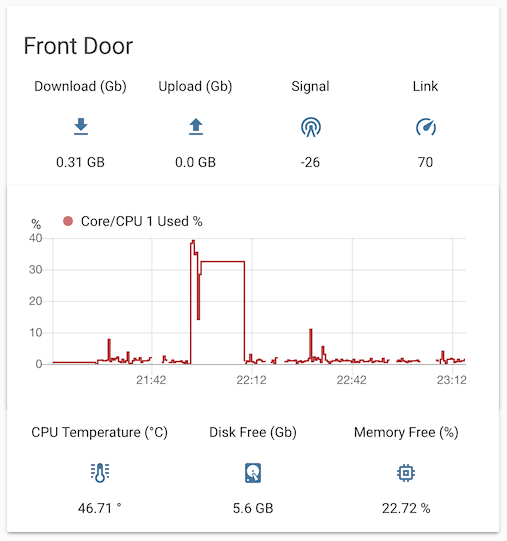Welcome to the lightweight "ha-monitor-api" project!
This is a quick-and-dirty lightweight API (knocked out in an evening) designed to expose the system's current metrics (such as disk, network, cpu/temperature etc) as a simple JSON endpoint that your Home Assistant instance can query.
It's been designed to run in a Docker Container (Ideally on your other hosts on your network - such as an external Raspberry Pi Webcam box, your Home-made weather station, or your DIY BLE/Zigbee Gateway etc - so that you can quickly feed metrics back to Home Assistant.
It does not aim to store metrics on disk, create fancy graphs etc - there's loads of other tools out there like Zabbix & Prometheus + Grafana etc - The primary goal of this tool is to expose a simple lightweight API that runs in a docker container exposing monitoring stats in real-time that can be fed into your other systems.
Docker Hub: bushrangers/ha-monitor-api
NOTE: The following system architectures are currently supported: arm, arm64, amd64. - If you're running on an architecture other than these the process will not start / you will need to build the docker image yourself.
- Docker
- Docker-compose
- Linux OS that you wish to monitor (such as a RaspberryPi etc)
It's pretty straightforward, just clone down the sources and stand up the container like so:
# Clone down sources on the host you want to monitor...
git clone https://github.com/ned-kelly/ha-monitor-api /opt/ha-monitor-api
cd /opt/ha-monitor-api
# Stand up the container
docker-compose up -d
By default the service listens on TCP:9999 (on all interfaces). If you need to change the port, you may do so by setting the LISTEN_PORT environment variable in your compose file.
Integrating into Home Assistant can be done like any other sensor using the RESTful Sensor.
An example here is taken from my OrangePI - (Running Facial Recognition by scraping all my friends's profile pictures off Facebook)...
Your (sensors/configuration.yaml) file:
# Sensor to monitor system resources for the Front Door PI.
- platform: rest
name: Front Door
resource: http://10.16.10.144:9999/
timeout: 30
json_attributes:
- cpu_current
- cpu_free
- cpu_average
- cpu_temperature
- drive
- memory
- network
value_template: '{{ value_json.value}}'
headers:
Content-Type: application/json
User-Agent: Home Assistant Agent
# To use the data on the Home Assistant Lovelace Dashboard we need to extract the values from the sensor, and store them as their own sensor values...
- platform: template
sensors:
front_door_cputemp:
value_template: '{{ states.sensor.front_door.attributes["cpu_temperature"] }}'
unit_of_measurement: '°'
entity_id: sensor.front_door
front_door_cpuused:
value_template: '{{ states.sensor.front_door.attributes["cpu_current"] }}'
unit_of_measurement: '%'
entity_id: sensor.front_door
front_door_freegb:
value_template: '{{ states.sensor.front_door.attributes["drive"]["freeGb"] }}'
unit_of_measurement: 'GB'
entity_id: sensor.front_door
front_door_driveused:
value_template: '{{ states.sensor.front_door.attributes["drive"]["usedPercentage"] }}'
unit_of_measurement: '%'
entity_id: sensor.front_door
front_door_freemem:
value_template: '{{ states.sensor.front_door.attributes["memory"]["freeMemPercentage"] }}'
unit_of_measurement: '%'
entity_id: sensor.front_door
front_door_networklevel:
value_template: '{{ states.sensor.front_door.attributes["network"]["wlan0"]["wireless"]["qualityLevel"] }}'
entity_id: sensor.front_door
front_door_networklink:
value_template: '{{ states.sensor.front_door.attributes["network"]["wlan0"]["wireless"]["qualityLink"] }}'
entity_id: sensor.front_door
front_door_networkin:
value_template: '{{ states.sensor.front_door.attributes["network"]["wlan0"]["inputBytes"] | multiply(0.000000001024) | round(2) }}'
entity_id: sensor.front_door
unit_of_measurement: 'GB'
front_door_networkout:
# Multiply pipe will convert bytes to gb.
value_template: '{{ states.sensor.front_door.attributes["network"]["wlan0"]["outputBytes"] | multiply(0.000000001024) | round(2) }}'
entity_id: sensor.front_door
unit_of_measurement: 'GB'
And of course, this data is all well and good - but what about putting it in the Lovelace UI? - I'm using the awesome "vertical-stack-in-card" here to combine multiple cards as one card like so:
Your Lovelace raw YAML config:
show_header_toggle: false
title: Front Door
type: 'custom:vertical-stack-in-card'
cards:
- type: glance
columns: 4
entities:
- entity: sensor.front_door_networkin
icon: 'mdi:download'
name: Download (Gb)
- entity: sensor.front_door_networkout
icon: 'mdi:upload'
name: Upload (Gb)
- entity: sensor.front_door_networklevel
icon: 'mdi:radio-tower'
name: Signal
- entity: sensor.front_door_networklink
icon: 'mdi:speedometer'
name: Link
- type: history-graph
entities:
- entity: sensor.front_door_cpuused
name: Core/CPU 1 Used %
- type: glance
columns: 3
entities:
- entity: sensor.front_door_cputemp
icon: 'mdi:thermometer-lines'
name: CPU Temperature (°C)
- entity: sensor.front_door_freegb
icon: 'mdi:harddisk'
name: Disk Free (Gb)
- entity: sensor.front_door_freemem
icon: 'mdi:memory'
name: Memory Free (%)This is still a work-in-progress and a quick-and-dirty hack in an evening into Home Assistant - PR's are welcome - obviously this project can also be used for much more than Home Assistant, but for now it's a great means to an end that uses minimal resources on my low-end SBC's.


